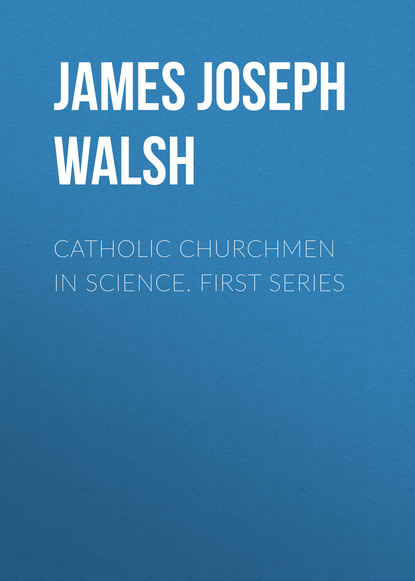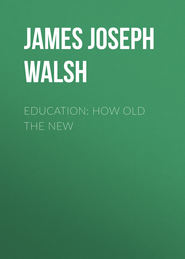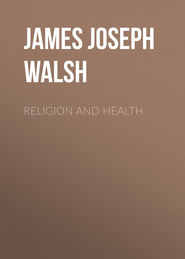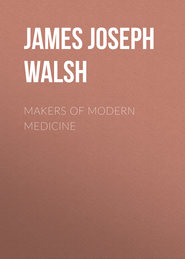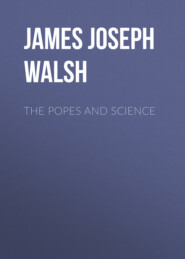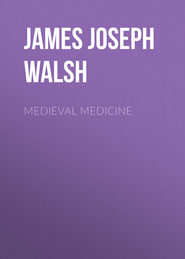По всем вопросам обращайтесь на: info@litportal.ru
(©) 2003-2024.
✖
Catholic Churchmen in Science. First Series
Настройки чтения
Размер шрифта
Высота строк
Поля
2. The center of the earth is not the center of the universe, but only the center of gravity and of the moon's orbit.
3. The planes of the orbits lie around the sun, which may be considered as the center of the universe.
4. The distance from the earth to the sun compared with that from the earth to the fixed stars is extremely small.
5. The daily motion of the heavenly sphere is apparent that is, it is an effect of the rotary motion of the earth upon it axis.
6. The apparent motions of the moon and of the sun are so different because of the effect produced by the motion of the earth.
7. The movements of the earth account for the apparent retrograde motion and other irregularities of the movements of the planets. It is enough to assume that the earth alone moves, in order to explain all the other movements observed in the heavens.
It is no wonder that one of his bishop-friends, Frisio, writing to another bishop-friend, Dantisco, said: "If Copernicus succeeds in demonstrating the truth of his thesis–and we may well consider that he will from this prelude–he will give us a new heaven and a new earth." This shorter exposition of Copernicus's views was found in manuscript in the imperial library in Vienna only about a quarter of a century ago. It is mentioned by Tycho Brahe in one of his works on astronomy in which he reviews the various contemporary advances made in the knowledge of the heavens.
The publication of Copernicus's great work, "De Revolutionibus Orbium Celestium," was delayed until he was advanced in years, because his astronomical opinions were constantly progressing; and, with the patience of true genius, he was not satisfied with anything less than the perfect expression of truth as he saw it. It has sometimes been said that it was delayed because Copernicus feared the storm of religious persecution which he foresaw it would surely arouse. How utterly without foundation is this pretence, which has unfortunately crept into serious history, can be seen from the fact that Pope Paul III accepted the dedication of the work; and of the twelve popes who immediately followed Paul not one even thought of proceeding against Copernicus's work. His teaching was never questioned by any of the Roman Congregations for nearly one hundred years after his death. Galileo's injudicious insistence in his presentation of Copernicus's doctrine, on the novelties of opinion that controverted long-established beliefs, was then responsible for the condemnation by the Congregation of the Index; and, as we shall see, this was not absolute, but only required that certain passages should be corrected. The corrections demanded were unimportant as regards the actual science, and merely insisted that Copernicus's teaching was hypothesis and not yet actual demonstration.
It must not be forgotten, after all, that the reasons advanced by Copernicus for his idea of the movements of the planets were not supported by any absolute demonstration, but only by reasons from analogy. Nearly a hundred years later than his time, even after the first discoveries had been made by the newly constructed telescopes, in Galileo's day, there was no absolute proof of the true system of the heavens. The famous Jesuit astronomer, Father Secchi, says the reasons adduced by Galileo were no real proofs: they were only certain analogies, and by no means excluded the possibility of the contrary propositions with regard to the movements of the heavens being true. "None of the real proofs for the earth's rotation upon its axis were known at the time of Galileo, nor were there direct conclusive arguments for the earth's moving around the sun." Even Galileo himself confessed that he had not any strict demonstration of his views, such as Cardinal Bellarmine requested. He wrote to the Cardinal, "The system seems to be true;" and he gave as a reason that it corresponded to the phenomena.
According to the astronomers of the time, however, the old Ptolemaic system, in the shape in which it was explained by the Danish astronomer Tycho Brahe, who was acknowledged as the greatest of European astronomers, appeared to give quite a satisfactory explanation of the phenomena observed. The English philosopher, Lord Bacon, more than a decade after Galileo's announcement, considered that there were certain phenomena in nature contrary to the Copernican theory, and so he rejected it altogether. This was within a few years of the condemnation by the Congregation at Rome. As pointed out by Father Heinzle, S.J., in his article on Galileo in the "Catholic World" for 1887, "science was so far from determining the question of the truth or falsity of either the Ptolemaic or the Copernican system that shortly before 1633, the year of Galileo's condemnation, a number of savants, such as Fromond in Louvain, Morin in Paris, Berigard in Pisa, Bartolinus in Copenhagen, and Scheiner in Rome, wrote against Copernicanism."
As we have said, Copernicus's book was not condemned unconditionally by the Roman authorities, but only until it should be corrected. This assured protection to the principal part of the work, and the warning issued by the Roman Congregation in the year 1820 particularizes the details that had to be corrected. It is interesting to note that whenever Copernicus is spoken of in this Monitum it is always in flattering terms as a "noble astrologer"–the word astrologer having at that time no unworthy meaning. The whole work is praised and its scientific quality acknowledged.
The passages requiring correction were not many. In the first book, at the beginning of the fifth chapter, Copernicus made the declaration that "the immobility of the earth was not a decided question, but was still open to discussion." In place of these words it was suggested that the following should be inserted: "In order to explain the apparent motions of the celestial bodies, it is a matter of indifference whether we admit that the earth occupies a place in the middle of the heavens or not."
In the eighth chapter of the first book, Copernicus said: "Why, then, this repugnance to concede to our globe its own movement as natural to it as is its spherical form? Why prefer to make the whole heavens revolve around it, with the great danger of disturbance that would result, instead of explaining all these apparent movements of the heavenly bodies by the real rotation of the earth, according to the words of AEneas, 'We are carried from the port, and the land and the cities recede'?" This passage was to be modified as follows: "Why not, then, admit a certain mobility of the earth corresponding to its form, since the whole universe of which we know the bounds is moved, producing appearances which recall to the mind the well-known saying of AEneas in Virgil, 'The land and the cities recede'?"
Toward the end of the same chapter Copernicus, continuing the same train of thought, says: "I do not fear to add that it is incomparably more unreasonable to make the immense vault of the heavens revolve than to admit the revolution of our little terrestrial globe." This passage was to be modified as follows: "In one case as well as in the other–that is, whether we admit the rotation of the earth or that of the heavenly spheres–we encounter the same difficulties."
The ninth chapter of the first book begins with these words: "There being no difficulty in admitting, then, the mobility of the earth, let us proceed to see whether it has one or a number of movements, and whether, therefore, our earth is a simple planet like the other planets." The following words were to be substituted: "Supposing, then, that the earth does move, it is necessary to examine whether this movement is multiple or not."
Toward the middle of the tenth chapter Copernicus declares: "I do not hesitate to defend the proposition that the earth, accompanied by the moon, moves around the sun;" while the wording of this proposition had to be changed so as to substitute the term "admit" for "defend." The title of the eleventh chapter, "Demonstration of the Triple Movement of the Earth," was modified to read as follows: "The Hypothesis of the Triple Movement of the Earth, and the Reasons Therefor." The title of the twentieth chapter of the fourth book originally read: "On the Size of the Three Stars [Sidera], the sun, the moon, and the earth." The word "stars" was removed from this title, the earth not being considered as a star. The concluding words of the tenth chapter of the first book, "So great is the magnificent work of the Omnipotent Artificer," had to be cancelled, because they expressed an assurance of the truth of his system not warranted by knowledge. With these few unimportant changes, any one might read and study Copernicus's work with perfect freedom.
Traditions to the contrary notwithstanding, Galileo, because of the friendship and encouragement of the churchmen in Italy, had been placed in conditions eminently suited for study and investigation. Several popes and a number of prominent ecclesiastics were his constant friends and patrons. The perpetual secretary of the Paris Academy of Sciences, M. Bertrand, himself a great mathematician and historian, declares that the long life of Galileo was one of the most enviable that is recorded in the history of science. "The tale of his misfortunes has confirmed the triumph of the truth for which he suffered. Let us tell the whole truth. This great lesson was learned without any profound sorrow to Galileo; and his long life, considered as a whole, was one of the most serene and enviable in the history of science."
Copernicus, like Galileo, had clerical friends to thank for an environment that proved the greatest possible aid to his scientific work. His position as Canon of the Cathedral of Frauenburg provided him with learned leisure, while his clerical friends took just enough interest in his investigations and the preliminary announcements of his discoveries to make his pursuit of astronomical studies to some definite conclusion a worthy aim in life. It was this assistance that enabled him to publish his book eventually and bring his great theory before the world.
Copernicus, far from having any leanings toward the so-called "reform" movement (as has often been asserted), was evidently a staunch supporter of his friend and patron Bishop Maurice Ferber, of Ermland, who kept his see loyal to Rome at a time when the secularization of the Teutonic order and the falling away of many bishops all around him make his position as a faithful son of the Church and that of his diocese noteworthy in the history of that time and place. It may well be said that under less favorable conditions Copernicus's work might never have been finished. As it was, his book met with great opposition from the Reformers, but remained absolutely acceptable even to the most rigorous churchmen until Galileo's unfortunate insistence on the points of it that were opposed to generally accepted theories.
During all his long life Copernicus remained one of the simplest of men. Genius as he was, he could not have failed to realize how great was the significance of the discoveries he had made in astronomy. In spite of this he continued to exercise during a long career the simple duties of his post as Canon of the Cathedral of Frauenberg, nor did he fail to give such time as was asked of him for the medical treatment of the poor or of his friends, the ecclesiastics of the neighborhood. These duties–as he seems to have considered them–must have taken many precious hours from his studies, but they were given unstintingly. When he came to die, his humility was even more prominent than during life. It was at his own request that there was graven upon his tombstone simply the prayer, "I ask not the grace accorded to Paul, not that given to Peter: give me only the favor Thou didst show to the thief on the cross." There is perhaps no better example in all the world of the simplicity of true genius nor any better example of how sublimely religious may be the soul that has far transcended the bounds of the scientific knowledge of its own day.
The greatness of Copernicus's life-work can best be realized from the extent to which he surpassed even well-known contemporaries in astronomy and from his practical anticipation of the opinions of some of his greatest successors. Even Tycho Brahe, important though he is in the history of astronomical science, taught many years after Copernicus's death the doctrine that the earth is the center of the universe. Newton had in Copernicus a precursor who divined the theory of universal gravitation; and even Kepler's great laws, especially the elliptical form of the orbits of the planets, are at least hinted at in Copernicus's writings. He is certainly one of the most original geniuses of all times; and it is interesting to find that the completeness of his scholarly career, far from being rendered abortive by friction with ecclesiastical superiors, as we might imagine probable from the traditions that hang around his name, was rather made possible by the sympathy and encouragement of clerical friends and Church authorities. Copernicus, the scholar, astronomer, physician, and clergyman, is a type of the eve of the Reformation period, and his life is the best possible refutation of the slanders with regard to the unprogressiveness of the Church and churchmen of that epoch which have unfortunately been only too common in the histories of the time.
III.
BASIL VALENTINE, FOUNDER OF MODERN CHEMISTRY
Let us, then, banish into the world of fiction that affirmation so long repeated by foolish credulity which made monasteries an asylum for indolence and incapacity, for misanthropy and pusillanimity, for feeble and melancholic temperaments, and for men who were no longer fit to serve society in the world. Monasteries were never intended to collect the invalids of the world. It was not the sick souls, but on the contrary the most vigorous and healthful the human race has ever produced, who presented themselves in crowds to fill them.–MONTALEMBERT, Monks of the West.
III.
BASIL VALENTINE, FOUNDER OF MODERN CHEMISTRY
The Protestant tradition which presumes a priori that no good can possibly have come out of the Nazareth of the times before the Reformation, and especially the immediately preceding century, has served to obscure to an unfortunate degree the history of several hundred years extremely important in every department of education. Strange as it may seem to those unfamiliar with the period, it is in that department which is supposed to be so typically modern the–physical sciences–that this neglect is most serious. Such a hold has this Protestant tradition on even educated minds that it is a source of great surprise to most people to be told that there were in many parts of Europe original observers in the physical sciences all during the thirteenth, fourteenth, and fifteenth centuries who were doing ground-breaking work of the highest value, work that was destined to mean much for the development of modern science. Speculations and experiments with regard to the philosopher's stone and the transmutation of metals are supposed to fill up all the interests of the alchemists of those days. As a matter of fact, however, men were making original observations of very profound significance, and these were considered so valuable by their contemporaries that, though printing had not yet been invented, even the immense labor involved in copying large folio volumes by hand did not suffice to deter them from multiplying the writings of these men and thus preserving them for future generations, until the printing-press came to perpetuate them.
At the beginning of the twentieth century, with some of the supposed foundations of modern chemistry crumbling to pieces under the influences of the peculiarly active light thrown upon older chemical theories by the discovery of radium and the radio-active elements generally, there is a reawakening of interest in some of the old-time chemical observers whose work used to be laughed at as so unscientific and whose theory of the transmutation of elements into one another was considered so absurd. The idea that it would be impossible under any circumstances to convert one element into another belongs entirely to the nineteenth century. Even so distinguished a mind as that of Newton, in the preceding century, could not bring itself to acknowledge the modern supposition of the absurdity of metallic transformation, but, on the contrary, believed very firmly in this as a basic chemical principle and confessed that it might be expected to occur at any time. He had seen specimens of gold ores in connexion with metallic copper, and had concluded that this was a manifestation of the natural transformation of one of these yellow metals into the other.
With the discovery that radium transforms itself into helium, and that indeed all the so-called radio-activities of the very heavy metals are probably due to a natural transmutation process constantly at work, the ideas of the older chemists cease entirely to be a subject for amusement. The physical chemists of the present day are very ready to admit that the old teaching of the absolute independence of something over seventy elements is no longer tenable, except as a working hypothesis. The doctrine of matter and form taught for so many centuries by the scholastic philosophers which proclaimed that all matter is composed of two principles, an underlying material substratum and a dynamic or informing principle, has now more acknowledged verisimilitude, or lies at least closer to the generally accepted ideas of the most progressive scientists, than it has at any time for the last two or three centuries. Not only the great physicists, but also the great chemists, are speculating along lines that suggest the existence of but one form of matter, modified according to the energies that it possesses under a varying physical and chemical environment. This is, after all, only a restatement in modern terms of the teaching of St. Thomas of Aquin in the thirteenth century.
It is not surprising, then, that there should be a reawakening of interest in the lives of some of the men who, dominated by the earlier scholastic ideas and by the tradition of the possibility of finding the philosopher's stone, which would transmute the baser metals into the precious metals, devoted themselves with quite as much zeal as any modern chemist to the observation of chemical phenomena. One of the most interesting of these–indeed he might well be said to be the greatest of the alchemists–is the man whose only name that we know is that which appears on a series of manuscripts written in the High German dialect of the end of the fifteenth and the beginning of the sixteenth century. That name is Basil Valentine, and the writer, according to the best historical traditions, was a Benedictine monk. The name Basil Valentine may only have been a pseudonym, for it has been impossible to trace it among the records of the monasteries of the time. That the writer was a monk there seems to be no doubt, for his writings in manuscript and printed form began to have their vogue at a time when there was little likelihood of their being attributed to a monk unless an indubitable tradition connected them with some monastery.
This Basil Valentine (to accept the only name we have), as we can judge very well from his writings, eminently deserves the designation of the last of the alchemists and the first of the chemists. There is practically a universal recognition of the fact now that he deserves also the title of Founder of Modern Chemistry, not only because of the value of the observations contained in his writings, but also because of the fact that they proved so suggestive to certain scientific geniuses during the century succeeding Valentine's life. Almost more than to have added to the precious heritage of knowledge for mankind is it a boon for a scientific observer to have awakened the spirit of observation in others and to be the founder of a new school of thought. This Basil Valentine undoubtedly did.
Besides, his work furnishes evidence that the investigating spirit was abroad just when it is usually supposed not to have been, for the Thuringian monk surely did not do all his investigating alone, but must have received as well as given many a suggestion to his contemporaries.
In the history of education there are two commonplaces that are appealed to oftener than any other as the sources of material with regard to the influence of the Catholic Church on education during the centuries preceding the Reformation. These are the supposed idleness of the monks, and the foolish belief in the transmutation of metals and the search for the philosopher's stone which dominated the minds of so many of the educated men of the time. It is in Germany especially that these two features of the pre-Reformation period are supposed to be best illustrated. In recent years, however, there has come quite a revolution in the feelings even of those outside of the Church with regard to the proper appreciation of the work of the monastic scholars of these earlier centuries. Even though some of them did dream golden dreams over their alembics, the love of knowledge meant more to them, as to the serious students of any age, than anything that might be made by it. As for their scientific beliefs, if there can be a conversion of one element into another, as seems true of radium, then the possibility of the transmutation of metals is not so absurd as, for a century or more, it has seemed; and it is not impossible that at some time even gold may be manufactured out of other metallic materials.
Of course, a still worthier change of mind has come over the attitude of educators because of the growing sense of appreciation for the wonderful work of the monks of the Middle Ages, and even of those centuries that are supposed to show least of the influence of these groups of men who, forgetting material progress, devoted themselves to the preservation and the cultivation of the things of the spirit. The impression that would consider the pre-Reformation monks in Germany as unworthy of their high calling in the great mass is almost entirely without foundation. Obscure though the lives of most of them were, many of them rose above their environment in such a way as to make their work landmarks in the history of progress for all time.
Because their discoveries are buried in the old Latin folios that are contained only in the best libraries, not often consulted by the modern scientist, it is usually thought that the scientific investigators of these centuries before the Reformation did no work that would be worth while considering in our present day. It is only some one who goes into this matter as a labor of love who will consider it worth his while to take the trouble seriously to consult these musty old tomes. Many a scholar, however, has found his labor well rewarded by the discovery of many an anticipation of modern science in these volumes so much neglected and where such treasure-trove is least expected. Professor Clifford Allbutt, the Regius Professor of physics at the University of Cambridge, in his address on "The Historical Relations of Medicine and Surgery Down to the End of the Sixteenth Century," which was delivered at the St. Louis Congress of Arts and Sciences during the Exposition in 1904, has shown how much that is supposed to be distinctly modern in medicine, and above all in surgery, was the subject of discussion at the French and Italian universities of the thirteenth century. William Salicet, for instance, who taught at the University of Bologna, published a large series of case histories, substituted the knife for the Arabic use of the cautery, described the danger of wounds of the neck, investigated the causes of the failure of healing by first intention, and sutured divided nerves. His pupil, Lanfranc, who taught later at the University of Paris, went farther than his master by distinguishing between venous and arterial hemorrhage, requiring digital compression for an hour to stop hemorrhage from the venae pulsatiles--the pulsating veins, as they were called–and if this failed because of the size of the vessel, suggesting the application of a ligature. Lanfranc's chapter on injuries to the head still remains a noteworthy book in surgery that establishes beyond a doubt how thoughtfully practical were these teachers in the medieval universities. It must be remembered that at this time all the teachers in universities, even those in the medical schools as well as those occupied with surgery, were clerics. Professor Allbutt calls attention over and over again to this fact, because it emphasizes the thoroughness of educational methods, in spite of the supposed difficulties that would lie in the way of an exclusively clerical teaching staff.
In chemistry the advances made during the thirteenth, fourteenth, and fifteenth centuries were even more noteworthy than those in any other department of science. Albertus Magnus, who taught at Paris, wrote no less than sixteen treatises on chemical subjects, and, notwithstanding the fact that he was a theologian as well as a scientist and that his printed works filled sixteen folio volumes, he somehow found the time to make many observations for himself and performed numberless experiments in order to clear up doubts. The larger histories of chemistry accord him his proper place and hail him as a great founder in chemistry and a pioneer in original investigation.
Even St. Thomas of Aquin, much as he was occupied with theology and philosophy, found some time to devote to chemical questions. After all, this is only what might have been expected of the favorite pupil of Albertus Magnus. Three treatises on chemical subjects from Aquinas's pen have been preserved for us, and it is to him that we are said to owe the origin of the word amalgam, which he first used in describing various chemical methods of metallic combination with mercury that were discovered in the search for the genuine transmutation of metals.
Albertus Magnus's other great scientific pupil, Roger Bacon, the English Franciscan friar, followed more closely in the physical scientific ways of his great master. Altogether he wrote some eighteen treatises on chemical subjects. For a long time it was considered that he was the inventor of gunpowder, though this is now known to have been introduced into Europe by the Arabs. Roger Bacon studied gunpowder and various other explosive combinations in considerable detail, and it is for this reason that he obtained the undeserved reputation of being an original discoverer in this line. How well he realized how much might be accomplished by means of the energy stored up in explosives can perhaps be best appreciated from the fact that he suggested that boats would go along the rivers and across the seas without either sails or oars and that carriages would go along the streets without horse or man power. He considered that man would eventually invent a method of harnessing these explosive mixtures and of utilizing their energies for his purposes without danger. It is curiously interesting to find, as we begin the twentieth century, and gasolene is so commonly used for the driving of automobiles and motor boats and is being introduced even on railroad cars in the West as the most available source of energy for suburban traffic, that this generation should only be fulfilling the idea of the old Franciscan friar of the thirteenth century, who prophesied that in explosives there was the secret of eventually manageable energy for transportation purposes.
Succeeding centuries were not as fruitful in great scientists as the thirteenth, and yet at the beginning of the fourteenth there was a pope, three of whose scientific treatises–one on the transmutation of metals, which he considers an impossibility, at least as far as the manufacture of gold and silver was concerned; a treatise on diseases of the eyes, of which Professor Allbutt[4 - Address cited] says that it was not without its distinctive practical value, though compiled so early in the history of eye surgery; and, finally, his treatise on the preservation of the health, written when he was himself over eighty years of age–are all considered by good authorities as worthy of the best scientific spirit of the time. This pope was John XXII, of whom it has been said over and over again by Protestant historians that he issued a bull forbidding chemistry, though he was himself one of the enthusiastic students of chemistry in his younger years and always retained his interest in the science[5 - For the refutation of this calumny with regard to John XXII, see "Pope John XXII and the supposed Bull forbidding Chemistry," by James J. Walsh, Ph. D., LL. D., in the Medical Library and Historical Journal, October, 1905.].
During the fourteenth century Arnold of Villanova, the inventor of nitric acid, and the two Hollanduses kept up the tradition of original investigation in chemistry. Altogether there are some dozen treatises from these three men on chemical subjects. The Hollanduses particularly did their work in a spirit of thoroughly frank, original investigation. They were more interested in minerals than in any other class of substances, but did not waste much time on the question of transmutation of metals. Professor Thompson, the professor of chemistry at Edinburgh, said in his history of chemistry many years ago that the Hollanduses have very clear descriptions of their processes of treating minerals in investigating their composition, which serve to show that their knowledge was by no means entirely theoretical or acquired only from books or by argumentation.
Before the end of this fourteenth century, according to the best authorities on this subject, Basil Valentine, the more particular subject of our essay, was born.
Valentine's career is a typical example of the personally obscure but intellectually brilliant lives which these old monks lived. It seems probable, according to the best authorities, as we have said, that his work began shortly before the middle of the fifteenth century, although most of what was important in it was accomplished during the second half. It would not be so surprising, as most people who have been brought up to consider the period just before the Reformation in Germany as wanting in progressive scholars might imagine, for a supremely great original investigator to have existed in North Germany about this time. After all, before the end of the century, Copernicus, the Pole, working in northern Germany, had announced his theory that the earth was not the center of the universe, and had set forth all that this announcement meant. To a bishop-friend who said to him, "But this means that you are giving us a new universe," he replied that the universe was already there, but his theory would lead men to recognize its existence. In southern Germany, Thomas à Kempis, who died in 1471, had traced for man the outlines of another universe, that of his own soul, from its mystically practical side. These great Germans were only the worthy contemporaries of many other German scholars scarcely less distinguished than these supreme geniuses. The second half of the fifteenth century, the beginning of the Renaissance in Germany as well as Italy, is that wonderful time in history when somehow men's eyes were opened to see farther and their minds broadened to gather in more of the truth of man's relation to the universe, than had ever before been the case in all the centuries of human existence, or than has ever been possible even in these more modern centuries, though supposedly we are the heirs of all the ages in the foremost files of time.
Coming as he did before printing, when the spirit of tradition was even more rife and dominating than it has been since, it is almost needless to say that there are many curious legends associated with the name of Basil Valentine. Two centuries before his time, Roger Bacon, doing his work in England, had succeeded in attracting so much attention even from the common people, because of his wonderful scientific discoveries, that his name became a by-word and many strange magical feats were attributed to him. Friar Bacon was the great wizard even in the plays of the Elizabethan period. A number of the same sort of myths attached themselves to the Benedictine monk of the fifteenth century. He was proclaimed in popular story to have been a wonderful magician. Even his manuscript, it was said, had not been published directly, but had been hidden in a pillar in the church attached to the monastery and had been discovered there after the splitting open of the pillar by a bolt of lightning from heaven. It is the extension of this tradition that has sometimes led to the assumption that Valentine lived in an earlier century, some even going so far as to say that he, too, like Roger Bacon, was a product of the thirteenth century. It seems reasonably possible, however, to separate the traditional from what is actual in his existence, and thus to obtain some idea at least of his work, if not of the details of his life. The internal evidence from his works enable the historian of science to place him within a half century of the discovery of America.
One of the stories told with regard to Basil Valentine, because it has become a commonplace in philology, has made him more generally known than any of his actual discoveries. In one of the most popular of the old-fashioned text-books of chemistry in use a quarter of a century ago, in the chapter on Antimony, there was a story that I suppose students never forgot. It was said that Basil Valentine, a monk of the Middle Ages, was the discoverer of this substance. After having experimented with it in a number of ways, he threw some of it out of his laboratory one day, where the swine of the monastery, finding it, proceeded to gobble it up together with some other refuse. He watched the effect upon the swine very carefully, and found that, after a preliminary period of digestive disturbance, these swine developed an enormous appetite and became fatter than any of the others. This seemed a rather desirable result, and Basil Valentine, ever on the search for the practical, thought that he might use the remedy to good purpose even on the members of the community.
Now, some of the monks in the monastery were of rather frail health and delicate constitution, and he thought that the putting on of a little fat in their case might be a good thing. Accordingly he administered, surreptitiously, some of the salts of antimony, with which he was experimenting, in the food served to these monks. The result, however, was not so favorable as in the case of the hogs. Indeed, according to one, though less authentic, version of the story, some of the poor monks, the unconscious subjects of the experiment, even perished as the result of the ingestion of the antimonial compounds. According to the better version they suffered only the usual unpleasant consequences of taking antimony, which are, however, quite enough for a fitting climax to the story. Basil Valentine called the new substance which he had discovered antimony, that is, opposed to monks. It might be good for hogs, but it was a form of monks' bane, as it were[6 - It is curious to trace how old are the traditions on which some of these old stories that must now be rejected, are founded. I have come upon the story with regard to Basil Valentine and the antimony and the monks in an old French medical encyclopedia of biography, published in the seventeenth century, and at that time there was no doubt at all expressed as to its truth. How much older than this it may be I do not know, though it is probable that it comes from the sixteenth century, when the kakoethes scribendi attacked many people because of the facility of printing, and when most of the good stories that have so worried the modern dry-as-dust historian in his researches for their correction became a part of the body of supposed historical tradition.].
Unfortunately for most of the good stories of history, modern criticism has nearly always failed to find any authentic basis for them, and they have had to go the way of the legends of Washington's hatchet and Tell's apple. We are sorry to say that that seems to be true also of this particular story. Antimony, the word, is very probably derived from certain dialectic forms of the Greek word for the metal, and the name is no more derived from anti and monachus than it is from anti and monos (opposed to single existence), another fictitious derivation that has been suggested, and one whose etymological value is supposed to consist in the fact that antimony is practically never found alone in nature.
Notwithstanding the apparent cloud of unfounded traditions that are associated with his name, there can be no doubt at all of the fact that Valentinus–to give him the Latin name by which he is commonly designated in foreign literatures–was one of the great geniuses who, working in obscurity, make precious steps into the unknown that enable humanity after them to see things more clearly than ever before. There are definite historical grounds for placing Basil Valentine as the first of the series of careful observers who differentiated chemistry from the old alchemy and applied its precious treasures of information to the uses of medicine. It was because of the study of Basil Valentine's work that Paracelsus broke away from the Galenic traditions, so supreme in medicine up to his time, and began our modern pharmaceutics. Following on the heels of Paracelsus came Van Helmont, the father of modern medical chemistry, and these three did more than any others to enlarge the scope of medication and to make observation rather than authority the most important criterion of truth in medicine. Indeed, the work of these three men dominated medicine, or at least the department of pharmaceutics, down almost to our own day, and their influence is still felt in drug-giving.
While we do not know the absolute date of either the birth or the death of Basil Valentine and are not sure even of the exact period in which he lived and did his work, we are sure that a great original observer about the time of the invention of printing studied mercury and sulphur and various salts, and above all, introduced antimony to the notice of the scientific world, and especially to the favor of practitioners of medicine. His book, "The Triumphal Chariot of Antimony," is full of conclusions not quite justified by his premises nor by his observations. There is no doubt, however, that the observational methods which he employed did give an immense amount of knowledge and formed the basis of the method of investigation by which the chemical side of medicine was to develop during the next two or three centuries. Great harm was done by the abuse of antimony, but then great harm is done by the abuse of anything, no matter how good it may be. For a time it came to be the most important drug in medicine and was only replaced by venesection.
The fact of the matter is that doctors were looking for effects from their drugs, and antimony is, above all things, effective. Patients, too, wished to see the effect of the medicines they took. They do so even yet, and when antimony was administered there was no doubt about its working.
Some five years ago, when Sir Michael Foster, M.D., professor of physiology in the University of Cambridge, England, was invited to deliver the Lane lectures at the Cooper Medical College, in San Francisco, he took for his subject "The History of Physiology." In the course of his lecture on "The Rise of Chemical Physiology" he began with the name of Basil Valentine, who first attracted men's attention to the many chemical substances around them that might be used in the treatment of disease, and said of him:–





